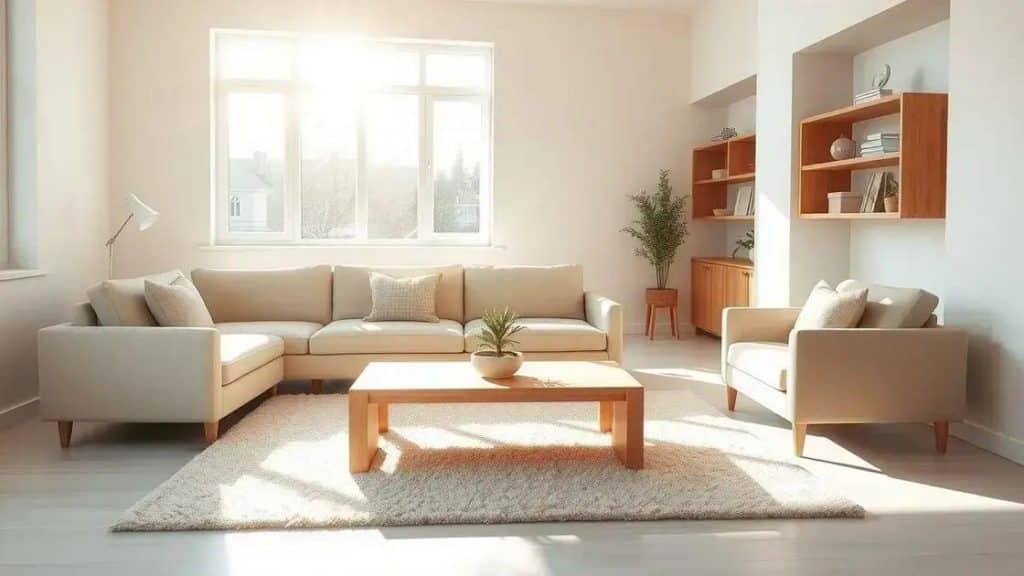Minimalist home decluttering checklist: your guide to freedom

A minimalist home decluttering checklist helps individuals systematically remove unnecessary items, prioritize belongings, and maintain a serene living space, fostering a more organized and fulfilling lifestyle.
Minimalist home decluttering checklist empowers you to reclaim your living space, making it more functional and serene.
Have you ever felt overwhelmed by clutter? This guide will provide practical tips to help you take the first steps towards a simpler, more organized home.
Minimalism in Home Organization Explained
Understanding minimalism in home organization is key to achieving a peaceful living space.
Minimalism focuses on the idea of simplifying your environment by removing excess belongings.
This approach is not just about cutting clutter; it’s about creating a home that reflects your true needs.
To begin, let’s consider what minimalism really means. It’s about making conscious choices regarding what we keep in our homes.
When we adopt a minimalist mindset, we prioritize quality over quantity, focusing on items that serve a purpose or bring joy.
Core Principles of Minimalism
There are some essential principles that can guide you in your journey towards minimalism:
- Intentionality: Every item in your home should have a specific purpose.
- Simplicity: Choose simple, functional designs that create a calm atmosphere.
- Quality: Invest in high-quality items that will last longer and reduce waste.
- Mindfulness: Regularly assess what you own and let go of what no longer serves you.
As you redefine your space, remember that minimalism is personal.
What feels minimal to one person may not feel the same to another. Therefore, it’s important to customize your approach.
Start small and gradually expand your efforts. You can begin with one room or even a single drawer.
Consider the feeling you want your home to evoke. A minimalist space often feels more open and inviting.
It can improve your mental clarity and provide a restorative atmosphere.
Understanding minimalism is the first step in transforming your home into a sanctuary that nurtures your well-being.
Steps to create your decluttering checklist

Creating your decluttering checklist is a vital step toward achieving a more organized home.
This checklist will help you stay focused and motivated throughout the decluttering process.
You can start by breaking down your tasks into manageable steps.
First, determine what areas in your home need the most attention.
It could be your kitchen, living room, or bedroom. Once you identify these spaces, write them down as specific sections in your checklist.
This keeps you organized and directly addresses each area that requires decluttering.
Identify Your Priorities
Next, prioritize these areas. Decide which spaces affect your daily life the most.
When you prioritize:
- Start with the most cluttered room. This will give you a sense of accomplishment.
- Focus on high-traffic areas. Decluttering these spaces improves comfort.
- Choose spaces that spark joy. Consider if items in these areas bring you happiness.
After prioritizing, consider setting specific goals for each area.
For example, aim to remove a certain number of items each day.
This makes your task feel less daunting and helps you track progress.
Create Categories for Decluttering
As you begin to sort through your belongings, create categories such as:
- Keep: Items that you use regularly or that have sentimental value.
- Donate:Items in good condition but that you no longer use.
- Trash: Broken or unusable items that need to be discarded.
- Sell: Items that may have value for others.
After sorting, check your categories regularly.
This will help you to reassess whether you still need the items you decided to keep.
Regularly updating your decluttering checklist will ensure it remains effective.
Tips for maintaining a minimalist lifestyle
Maintaining a minimalist lifestyle goes beyond decluttering your home; it’s about embracing simplicity in every aspect of your life.
To keep your living space serene, there are practical tips that can help you stay on track.
First, cultivate awareness of what you bring into your home.
Before acquiring new items, ask yourself if they truly serve a purpose or if they add value to your life.
This habit keeps unnecessary clutter from accumulating.
Regularly Reassess Your Belongings
Next, make it a habit to regularly assess what you own.
You can:
- Set a schedule. Consider doing a monthly check to evaluate your items.
- Declutter intentionally. If something no longer serves you, let it go.
- Maintain only what you love. Keep items that bring joy and utility.
Another vital aspect of maintaining a minimalist lifestyle is organizing effectively.
Use clear storage solutions to keep your belongings easily accessible yet out of sight.
Containers and labels simplify finding what you need and also encourage a tidy environment.
Practice Mindful Consumption
Mindfulness in your consumption habits is crucial as well. Focus on quality over quantity when shopping.
Consider the long-term benefits of a purchase rather than immediate satisfaction.
This approach reduces waste and enhances satisfaction with what you choose to keep.
Creating routines can also support a minimalist lifestyle. Simple cleaning habits like tidying up at the end of the day prevent clutter build-up and keep your space organized.
Finally, surround yourself with like-minded individuals who support your minimalist goals. Their influence can reinforce your lifestyle choices.
Avoiding common decluttering mistakes

Avoiding common decluttering mistakes is crucial for maintaining an organized space.
Even with the best intentions, it’s easy to fall into traps that can hinder your progress.
Understanding these pitfalls can help you stay on track as you simplify your home.
One major mistake is trying to declutter everything at once. This can be overwhelming and lead to frustration.
Instead, focus on one area or room at a time. Breaking down your tasks into smaller, manageable parts will ensure you remain motivated.
Setting Unrealistic Goals
Another common error is setting unrealistic goals for your decluttering sessions.
When you expect too much, you may feel discouraged if you don’t achieve what you planned.
Consider:
- Setting a time limit. Allocate a specific amount of time for each session, like 30 minutes to an hour.
- Choosing a specific number of items to remove. Aim to let go of a few items, rather than an entire room’s worth.
- Celebrating small wins. Each time you complete a decluttering session, acknowledge your progress.
Another mistake is not having a clear plan for the items you no longer need. Simply putting them in a pile won’t help you declutter effectively.
Instead, create a system for how you’ll deal with these items.
Whether it’s donating, selling, or recycling, designate a spot for each category.
Being Too Sentimental
Many people struggle with letting go of items due to sentimental value.
It’s natural to hold onto belongings that remind you of special moments.
To manage this:
- Limit your keepsakes. Select a few items that truly represent meaningful memories.
- Take photos of items. Instead of keeping everything, photograph items to preserve the memory.
- Consider their value. Ask yourself if they still serve a purpose in your life today.
Finally, avoid falling into the trap of indecision. While it’s normal to hesitate about certain items, prolonged indecision can halt your decluttering progress. Trust your instincts and make quick decisions based on utility and joy.
By avoiding these common decluttering mistakes, you’ll enhance your journey towards a minimalist lifestyle.
In conclusion, maintaining a minimalist lifestyle is not just about decluttering your space; it’s about creating a sense of peace and freedom in your life.
By avoiding common mistakes, staying intentional with your belongings, and embracing simplicity, you can enjoy the benefits of a more organized and fulfilling home.
Remember that small steps lead to big changes, so be patient with yourself as you refine your living space.
With each item you let go of, you are making room for what truly matters in your life.





